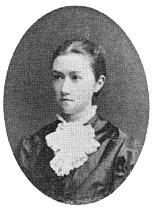

 | | 
|
|---|
 There are some people who achieve great things with very limited means, purely through their own genius, hard work, and in the face of great obstacles. Such a person was Agnes Pockels.
There are some people who achieve great things with very limited means, purely through their own genius, hard work, and in the face of great obstacles. Such a person was Agnes Pockels.
Ms. Pockels was born in 1862 in Venice at the time when Venice belonged to Austria. She was the daughter of Theodor Pockels, an officer in the Austrian Army and his wife Alwine, nee Becker. Her brother Friedrich was born three years later. Due to the then unhealthy conditions in Northern Italy, the whole family was afflicted with malaria. Partly because of this, and partly because of political changes, Mr. Pockels took early retirement, and the family moved to Braunschweig (Brunswick). There Agnes visited the local Girl's High School, where her favorite subject was Physics.
She would have liked to go on to get a higher education, but at that time women were not admitted to University. Also, she was needed at home to look after her ailing parents. But when her brother began studying Physics, she would borrow his books and study on her own.
She soon began observing a thing she handled daily, dirty dishwater. She began making quantitative observations and soon found herself in need of an apparatus for measuring the surface tension under varying conditions. So she designed one from an old meat extract can, a button on a silk thread, some rulers, and an apothecary balance. She kept a careful diary of all her observations in a school notebook. Soon she had someone make her a better model of the trough she used and she began making systematic measurements.
Her brother gave her an introduction to some professors at the University of Goettingen, but when they saw this young girl with her notebooks, the reaction was as expected. . . a rebuff.
Then she saw a publication in a paper called "Survey of Natural Sciences" by John William Strutt, Third Baron Raleigh, on a subject related to what she was doing. So she wrote him on January 10, 1891, a 12-page letter, outlining her work. He immediately recognized the quality of her work and saw that it got published in Nature.
Now things began to move. Over the next 30 years, she published a number of papers. In 1893, the University of Goettingen offered her research space, but due to her domestic obligations she could no avail herself of it. But she gained wide recognition in her field, and in 1932, three years before her death, she was awarded the Laura- Leonard Prize and an honorary Ph.D. in engineering by the Technical University of Brunswyck.
— Written by Astrid Phillips